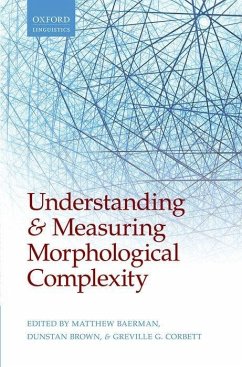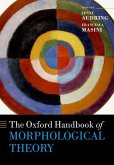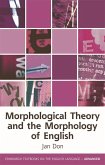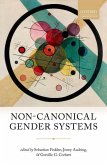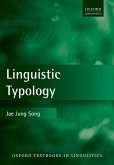Understanding and Measuring Morphological Complexity
Herausgeber: Baerman, Matthew
Understanding and Measuring Morphological Complexity
Herausgeber: Baerman, Matthew
- Gebundenes Buch
- Merkliste
- Auf die Merkliste
- Bewerten Bewerten
- Teilen
- Produkt teilen
- Produkterinnerung
- Produkterinnerung
This book aims to assess the nature of morphological complexity, and the properties that distinguish it from the complexity manifested in other components of language. Chapters highlight novel perspectives on conceptualizing morphological complexity, and offer concrete means for measuring, quantifying and analysing it.
Andere Kunden interessierten sich auch für
![Defaults in Morphological Theory Defaults in Morphological Theory]() Defaults in Morphological Theory140,99 €
Defaults in Morphological Theory140,99 €![The Oxford Handbook of Morphological Theory The Oxford Handbook of Morphological Theory]() The Oxford Handbook of Morphological Theory200,99 €
The Oxford Handbook of Morphological Theory200,99 €![Morphological Perspectives Morphological Perspectives]() Morphological Perspectives163,99 €
Morphological Perspectives163,99 €![Morphological Theory and the Morphology of English Morphological Theory and the Morphology of English]() Jan DonMorphological Theory and the Morphology of English145,99 €
Jan DonMorphological Theory and the Morphology of English145,99 €![Non-Canonical Gender Systems Non-Canonical Gender Systems]() Non-Canonical Gender Systems131,99 €
Non-Canonical Gender Systems131,99 €![Linguistic Typology Linguistic Typology]() Jae Jung SongLinguistic Typology167,99 €
Jae Jung SongLinguistic Typology167,99 €![Person, Case, and Agreement Person, Case, and Agreement]() András BárányPerson, Case, and Agreement131,99 €
András BárányPerson, Case, and Agreement131,99 €-
-
-
This book aims to assess the nature of morphological complexity, and the properties that distinguish it from the complexity manifested in other components of language. Chapters highlight novel perspectives on conceptualizing morphological complexity, and offer concrete means for measuring, quantifying and analysing it.
Produktdetails
- Produktdetails
- Verlag: Oxford University Press (UK)
- Seitenzahl: 238
- Erscheinungstermin: 26. Mai 2015
- Englisch
- Abmessung: 234mm x 155mm x 20mm
- Gewicht: 499g
- ISBN-13: 9780198723769
- ISBN-10: 0198723768
- Artikelnr.: 47868196
- Herstellerkennzeichnung
- Libri GmbH
- Europaallee 1
- 36244 Bad Hersfeld
- gpsr@libri.de
- Verlag: Oxford University Press (UK)
- Seitenzahl: 238
- Erscheinungstermin: 26. Mai 2015
- Englisch
- Abmessung: 234mm x 155mm x 20mm
- Gewicht: 499g
- ISBN-13: 9780198723769
- ISBN-10: 0198723768
- Artikelnr.: 47868196
- Herstellerkennzeichnung
- Libri GmbH
- Europaallee 1
- 36244 Bad Hersfeld
- gpsr@libri.de
Matthew Baerman is a research fellow in the Surrey Morphology Group at the University of Surrey. His research focuses on the typology, diachrony and formal analysis of inflectional systems, with a particular concentration on phenomena whose interpretation is problematic or controversial. His work has appeared in such journals as Language, Journal of Linguistics, Morphology, Lingua, and Natural Language and Linguistic Theory. He is the editor of OUP's forthcoming Oxford Handbook of Inflection. Matthew Baerman, Dunstan Brown, and Greville G. Corbett are joint authors of The Syntax-Morphology Interface: A Study of Syncretism (CUP 2005). Dunstan Brown holds an Anniversary Chair in the Department of Language and Linguistic Science, University of York. His research interests include autonomous morphology, morphology-syntax interaction and typology. Much of his work focuses on understanding morphological complexity, such as syncretism and computational modelling of morphological systems. His publications include Network Morphology (with Andrew Hippisley; CUP 2012) and Canonical Morphology and Syntax (co-edited with Marina Chumakina and Greville G. Corbett; OUP 2012). Greville G. Corbett is Distinguished Professor of Linguistics at the University of Surrey, where he leads the Surrey Morphology Group. He works on the typology of features, as in Gender (1991), Number (2000), Agreement (2006), and Features (2012), all published by Cambridge University Press. His recent research has been within the canonical approach to typology and he is one of the originators of Network Morphology. He is co-editor, with Dunstan Brown and Marina Chumakina, of Canonical Morphology and Syntax (OUP 2012)
* Part I What is Morphological Complexity?
* 1: Matthew Baerman, Dunstan Brown, and Greville G. Corbett:
Understanding and measuring morphological complexity: An introduction
* 2: Stephen Anderson: Dimensions of morphological complexity
* Part II Understanding Complexity
* 3: Erich R. Round: Rhizomorphomes, meromorphomes, and metamorphomes
* 4: Mark Donohue: Morphological opacity: Rules of referral in Kanum
verbs
* 5: Jean-Pierre Koenig and Karin Michelson: Oneida pronominal
complexity: An upper-bound on morphological complexity?
* 6: Marina Chumakina and Greville G. Corbett: Gender-number marking in
Archi: Small is complex
* Part III Measuring Complexity
* 7: Gregory Stump and Raphael A. Finkel: Contrasting modes of
representation for inflectional systems: Some implications for
computing morphological complexity
* 8: Vito Pirrelli, Marcello Ferro, and Claudia Marz: Computational
complexity of abstractive morpholog
* 9: Paolo Milizia: Patterns of syncretism and paradigm complexity: The
case of Old and Middle Indic declen
* 10: Sebastian Bank and Jochen Trommer: Learning and the complexity of
Ø-marking
* 1: Matthew Baerman, Dunstan Brown, and Greville G. Corbett:
Understanding and measuring morphological complexity: An introduction
* 2: Stephen Anderson: Dimensions of morphological complexity
* Part II Understanding Complexity
* 3: Erich R. Round: Rhizomorphomes, meromorphomes, and metamorphomes
* 4: Mark Donohue: Morphological opacity: Rules of referral in Kanum
verbs
* 5: Jean-Pierre Koenig and Karin Michelson: Oneida pronominal
complexity: An upper-bound on morphological complexity?
* 6: Marina Chumakina and Greville G. Corbett: Gender-number marking in
Archi: Small is complex
* Part III Measuring Complexity
* 7: Gregory Stump and Raphael A. Finkel: Contrasting modes of
representation for inflectional systems: Some implications for
computing morphological complexity
* 8: Vito Pirrelli, Marcello Ferro, and Claudia Marz: Computational
complexity of abstractive morpholog
* 9: Paolo Milizia: Patterns of syncretism and paradigm complexity: The
case of Old and Middle Indic declen
* 10: Sebastian Bank and Jochen Trommer: Learning and the complexity of
Ø-marking
* Part I What is Morphological Complexity?
* 1: Matthew Baerman, Dunstan Brown, and Greville G. Corbett:
Understanding and measuring morphological complexity: An introduction
* 2: Stephen Anderson: Dimensions of morphological complexity
* Part II Understanding Complexity
* 3: Erich R. Round: Rhizomorphomes, meromorphomes, and metamorphomes
* 4: Mark Donohue: Morphological opacity: Rules of referral in Kanum
verbs
* 5: Jean-Pierre Koenig and Karin Michelson: Oneida pronominal
complexity: An upper-bound on morphological complexity?
* 6: Marina Chumakina and Greville G. Corbett: Gender-number marking in
Archi: Small is complex
* Part III Measuring Complexity
* 7: Gregory Stump and Raphael A. Finkel: Contrasting modes of
representation for inflectional systems: Some implications for
computing morphological complexity
* 8: Vito Pirrelli, Marcello Ferro, and Claudia Marz: Computational
complexity of abstractive morpholog
* 9: Paolo Milizia: Patterns of syncretism and paradigm complexity: The
case of Old and Middle Indic declen
* 10: Sebastian Bank and Jochen Trommer: Learning and the complexity of
Ø-marking
* 1: Matthew Baerman, Dunstan Brown, and Greville G. Corbett:
Understanding and measuring morphological complexity: An introduction
* 2: Stephen Anderson: Dimensions of morphological complexity
* Part II Understanding Complexity
* 3: Erich R. Round: Rhizomorphomes, meromorphomes, and metamorphomes
* 4: Mark Donohue: Morphological opacity: Rules of referral in Kanum
verbs
* 5: Jean-Pierre Koenig and Karin Michelson: Oneida pronominal
complexity: An upper-bound on morphological complexity?
* 6: Marina Chumakina and Greville G. Corbett: Gender-number marking in
Archi: Small is complex
* Part III Measuring Complexity
* 7: Gregory Stump and Raphael A. Finkel: Contrasting modes of
representation for inflectional systems: Some implications for
computing morphological complexity
* 8: Vito Pirrelli, Marcello Ferro, and Claudia Marz: Computational
complexity of abstractive morpholog
* 9: Paolo Milizia: Patterns of syncretism and paradigm complexity: The
case of Old and Middle Indic declen
* 10: Sebastian Bank and Jochen Trommer: Learning and the complexity of
Ø-marking

